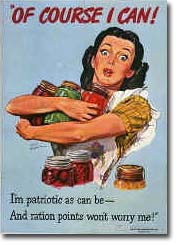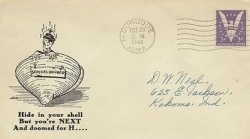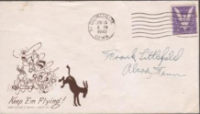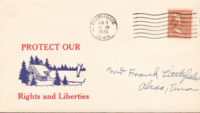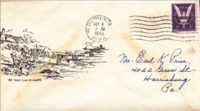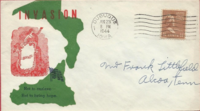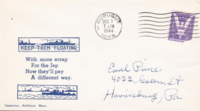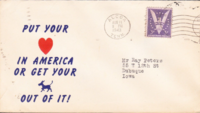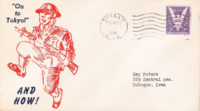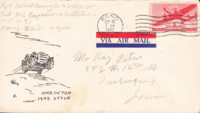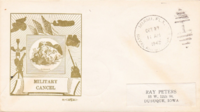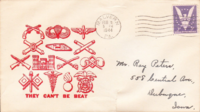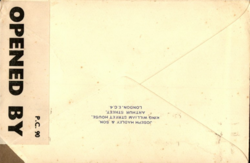Encyclopedia Dubuque
"Encyclopedia Dubuque is the online authority for all things Dubuque, written by the people who know the city best.”
Marshall Cohen—researcher and producer, CNN
Affiliated with the Local History Network of the State Historical Society of Iowa, and the Iowa Museum Association.
WORLD WAR II
WORLD WAR II. Global war fought between 1939 and 1945. The bombing of Pearl Harbor by the Japanese on December 7, 1941 brought an end to speeches made by people like Archbishop Francis J.L. BECKMAN. Protest marches of conscientious objectors like those joined by Louise Herron HALLIBURTON disappeared. In the United States, Nazi sympathizers like Frederick Wilhelm KALTENBACH either left the country or grew silent.
Following the Japanese attack on Pearl Harbor, the United States Congress declared war on Japan. When Germany then declared war on the United States, Congress voted war against Germany. In Iowa a total of 882,542 men registered and 262,638 men and women entered military service.
The personal convictions of some healthy men kept them from enlisting. Some men objected on religious and moral grounds to participating in violence. Some belonged to churches that have historically objected to war. In WORLD WAR I, these conscientious objectors were jailed. (1)
As World War II developed, Congress, for the first time in history, recognized "CO Status" as a legitimate moral stand. Under the law, objectors had two choices — they could go into the military but serve in the medical corps or other non-combat duties, or they were required to do "alternative service" here at home that was "work of national importance." At the University of Minnesota, Dr. Ansel Keyes — the inventor of K-ration meals for GIs — was commissioned to find out how millions of starving refugees in Europe and Asia could be brought back to health after the war. He asked for volunteers from CPS conscientious objector units. Two-hundred COs volunteered, and 36 were chosen for the project. The volunteers were starved, studied and then fed back to health. (2)
On July 13, 1941 the first organized farewell party for Dubuque County draftees was held with a crowd estimated at 2,500 attending. The success of the event led officials to consider having a party for each contingent called up. An on-the-scenes broadcast on radio station KDTH was joined by Mayor Albert WHARTON. (3)
America's railroads played a major role in the war effort. Each month they were called upon to transport one million service personnel. This required 4,000 baggage cars, 14,000 Pullman cars, and 12,000 day coaches. The call of "troop train" led children to run for the tracks where soldiers in passing cars often threw candy bars to the crowds. The volume of freight traffic increased 95% between 1940 and 1943. (4)
Local women volunteered to do knitting and sewing for the American Red Cross. Between the beginning of the war in the Pacific on December 7, 1941 and December 21, 1941 the Dubuque County chapter sent 1,744 garments which were sent overseas to aid noncombatants. In late 1941 a quota had been accepted for clothing for American servicemen with the first going to those serving in the North Atlantic patrol. (5)
War relief efforts of the American Red Cross included "minute speakers." On one occasion in January, 1942, one hundred fifty eight volunteers were involved in bringing brief message about a drive to raise $20,000 to all audiences in theaters on Saturday night and Sunday. Companies agreed to sound whistles at a given hour to remind workers to go to special money collection sites. (6) Even school children were made to feel they were playing an important part in defending their country. In "pencil rooms" where students could purchase needed supplies, they were able to purchase stamps to place in their stamp album. After reaching a total of $18.75, they were able to exchange the album for a War Savings Bond.
The public library made its own unique contributions. To aid in the writing of the history of Dubuque County in the war, the library compiled lists of names of every man or woman entering military service. This information and any news of this person were kept on file cards. Clippings were made of every organization's efforts at helping our troops or their families at home and conducted book drives for soldiers. A new oil burning furnace was installed and three rooms were closed to increase heating efficiency. The County Library was added to the Carnegie-Stout as a branch and the county supervisors voted for a tax to provide rural library service. (7)
The experience of our ships being sunk at Pearl Harbor destroyed the comfort Americans felt being surrounded by wide oceans. There was fear of attacks on the United States. The JULIEN DUBUQUE BRIDGE was painted gray to make it difficult to see from the air. (8)
It was decided that America needed some form of defense against the possibility of enemy attack. In May 1941, President Roosevelt created the OFFICE OF CIVILIAN DEFENSE (OCD). This was put into place to organize the thousands of Americans who wanted to volunteer their services.
In May 1943 a practice "blackout" was carried out by the officials of the Dubuque Civilian Defense Corps. According to the plan, the Civilian Defense office in Des Moines would flash the order to Davenport, the air raid warning center for this district. Davenport would immediately notify the sheriffs of the six county region. The sheriffs would contact the commanders of the Civilian Defense Corps in each community. Commanders notified all division chiefs who would contact their own units. The "alert" would be given in plenty of time for Civilian Defense workers to reach their posts. (9) On July 30th a surprise "blackout" drill was held. The results were considered satisfactory although "a few display signs and window lights were seen along Main Street." (10)
Rationing was a part of every citizen's life. In Dubuque as elsewhere coffee and sugar were rationed using Ration Book 1. Rationing of other goods was expected to begin in February, 1943 and would apply to:
Canned--fruit, vegetables, soups, juices, baby food
Bottled--juices, chili sauce, soups, catsup
Frozen--fruits and vegetables
Dried--fruits
Jar goods--fruits, vegetables, soups and juices
Meat would be rationed later. Rationing would continue
on coffee and sugar.
Under the program, shoppers could visit any store buying expensive or cheap brands. The amount of goods, however, would be limited. High-point goods would mean that an individual could buy less. Retail selling the week prior to the rationing going into effect was stopped to allow shop-keepers a chance to replenish their stock, train staff, and to receive their list of point values. The public would also need to register for Book 2 and become familiar with the program.
Recipients of Ration Book 2 had several obligations. First, they had to fill out and sign a "Consumer Declaration" form stating the amount of goods they currently had on hand. Heavy penalties were assessed any one filing a false statement. Home canned goods were not included. Second, they had to have with them all Ration Book 1's assigned to their home. Third, the amount of coffee at home as of November 1942 had to be stated. Once these obligations were fulfilled, they received a Ration Book 2 for each member of the household regardless of age.
Ration Book 2 contained two colors of stamps. Red stamps applied to meat while blue stamps were used for canned goods. Since meat was not yet rationed, blue stamps were used first. Each stamp had both a letter and a number. The letter indicated when the stamp had to be used. The number showed its value. The letters ran A-Z (I and O were omitted). Each letter appeared on four stamps. There were 96 blue stamps in each book. One of the four stamps with each letter had a number 8, one carried a 5, one carried a 3, and one stamp carried the number 1.
Stamps were used in three letter groups. Stamps A-B-C were used during one period. The length of a ration period was announced by the Office of Price Administration (OPA). Since each letter appeared on four stamps, a total of twelve stamps could be used during each ration period. During a ration period, an individual would have three 8-point stamps, three 5-point stamps, three 3-point stamps and three 1-point stamps. There would therefore by a 48 point total for each ration period. Abundant foods carried low points needed to purchase them. The OPA listed point values of different foods in the newspaper and the information was posted in grocery stores. Points would be the same although the price charged in different stores could vary. (11)
Records were carefully kept of who received ration books. Relatives of those who had died or joined the military were required to return their books to the local ration board. (12) The "loss" of ration books posed serious problems. The Dubuque Ration Board was ordered to strictly follow regulations which stated there was a sixty day waiting period before issuing new books. Ration books which were found were to be returned to their owner. The unlawful use of ration books was subject to severe penalties. (13)
Rationing was eventually applied to other items: (14)
Tires January 1942 to December 1945
Cars February 1942 to October 1945
Bicycles July 1942 to September 1945
Gasoline May 1942 to August 1945
Fuel Oil & Kerosene October 1942 to August 1945
Solid Fuels September 1943 to August 1945
Stoves December 1942 to August 1945
Rubber Footwear October 1942 to September 1945
Shoes February 1943 to October 1945
Sugar May 1942 to 1947
Coffee November 1942 to July 1943
Processed Foods March 1943 to August 1945
Meats, canned fish March 1943 to November 1945
Cheese, canned milk, fats March 1943 to November 1945
Typewriters March 1942 to April 1944
Quotas varied throughout the war. In May 1943, as example the quotas for tires to Dubuque County and others in the Des Moines District were sharply reduced. Quotas for Dubuque County were 214 Grade I (new) tires; 296 Grade III (used or recapped) tires; 146 truck tires; and 35 farm tractor and implement tires. (15) There were no restrictions regarding repairing or recapping passenger tires because only reclaimed rubber was used in the process. Office of Price Administration officials were quoted as saying due to the extreme scarcity of natural rubber, it was essential that tires be recapped as many times as possible in order to reduce the demand for new tires. (16) Rationing ended when supplies were considered sufficient.
At home where “food will win the war” was an important slogan. Individual families were encouraged to plant a VICTORY GARDEN. Iowa’s agricultural possibilities were stretched to breaking. In 1930 Iowa’s farm products had a value of $690,302,406 and there were 214,928 farms. In 1945 the number of farms had decreased to 208,934 but the value of the crops had risen to $1,232,010,705.
Iowa also played an important role in the manufacture of war implements. Finding definite statistics of production is difficult because some of the manufacturing was secret. However, it is known that in 1939 there were 64,773 production workers in 2,541 industrial plants creating production worth $243,390,000. In 1947 112,490 employed worked in 2,965 plants with the value of production rising to $671,100,000. Many firms won the prized E award for excellence in production.
In Dubuque, many companies converted their operations to produce goods for war. Klauer Optical ground lenses for high-powered binoculars used for gauging tank and artillery fire. A.Y.MCDONALD MANUFACTURING COMPANY made gas nozzles, valves, and other products for the Navy and Air Force. FARLEY AND LOETSCHER MANUFACTURING COMPANY made thousands of wooden foot lockers, munitions boxes, and doors and windows for military barracks. DUBUQUE AWNING & TENT COMPANY manufactured canvas goods for the military.
Since many males left their jobs to join the military, companies found themselves short of laborers. This created more opportunities for women wishing to work outside the home. Although the popular image of "Rosie, the Riveter" pictured men and women working side-by-side at the same jobs, men and women were often placed in separate jobs.
In Dubuque, GENERAL DRY BATTERIES reached its peak employment with 1,100 women and 500 men. Women began work by sweeping. This continued until one by one they were chosen for other work. Men, for example, were often given work with machines while women were assigned to assembly jobs. With the start of war, the company went on three shifts--twenty-four hours a day--with employees being encouraged to work seven days. INTERSTATE POWER COMPANY operated special bus lines for the employees and those who lived beyond the bus lines received extra ration stamps for gasoline. Women who did the same work as men found themselves earning less for the same work. When the war ended, however, many of the women remained in the workforce proving themselves to employers who relied on their abilities. (17)
Father Michael J. Martin, president of LORAS COLLEGE, signed a contract with the United States Navy in 1942, through the Civil Aeronautics Administration War Training Service, for the college to participate in training aviation cadets in Navy V-1, V-5, and 4-7 programs. (18) Iowans in uniform played important roles in the war. Reverend Albert HOFFMAN became the most decorated American chaplain of the war and lost his left leg in Italy while helping a dying soldier. Among the heroes who received special comment were Harold E. HANTELMANN, John M. AUSTIN, Theodore Richards ELLSWORTH, Fredric L. GALLIART, Ray A. MILVERSTED, Robert L. MARTIN, Robert H. THELEN, Arthur C. TOEPEL, and George F. UNMACHT.Records indicate that 263,000 Iowans served in the military during World War II. There were 4,255 killed and 11,724 wounded.
Veterans of World War II were provided with opportunities to further their education. Congress passed the "G.I. Bill" making vocational or college education available to every honorably discharged veteran. College enrollment which had dropped during the war grew at Loras, for example, from 394 in 1944, 614 in 1945, and 1,387 in 1946. (19)
Many veterans of the war were given the opportunity to participate in HONOR FLIGHT DUBUQUE.
Among those who died was Lieutenant Robert J. BREITBACH, one of five Army Air Force men, who perished in a crash of a B-17 bomber on the J.W. Seifker farm west of CENTER GROVE on February 8, 1944. The plane from Chanute Field, Rantoul, Illinois, was on a routine training flight with Breitbach as the pilot. The plane smashed through a tree before ramming into a hillside, exploding and then bursting into flames. Father Aloysius SCHMITT made the supreme sacrifice helping others at Pearl Harbor.
See: DOGS FOR DEFENSE







